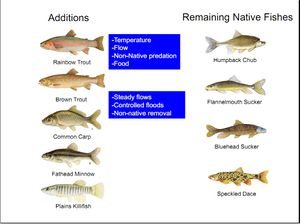Difference between revisions of "FISH"
Cellsworth (Talk | contribs) |
Cellsworth (Talk | contribs) |
||
| Line 12: | Line 12: | ||
<tr style='mso-yfti-irow:0;mso-yfti-firstrow:yes'> | <tr style='mso-yfti-irow:0;mso-yfti-firstrow:yes'> | ||
<td width=40% valign=bottom align=left style='width:2.05in;padding:0in 5.4pt 0in 5.4pt'> | <td width=40% valign=bottom align=left style='width:2.05in;padding:0in 5.4pt 0in 5.4pt'> | ||
| − | <p class=MsoNormal>[]</p> | + | <p class=MsoNormal>[[File:Additions and Remaining Native Fishes Slide 9.jpg |thumb]]</p> |
</td> | </td> | ||
</tr> | </tr> | ||
| Line 20: | Line 20: | ||
------------Portal list on righthand side----------> | ------------Portal list on righthand side----------> | ||
| − | |style="width: | + | |style="width:100%; font-size:100%;"| |
| − | + | ||
| − | + | ||
| − | + | ||
| − | + | ||
| − | + | ||
| − | + | ||
| − | + | ||
| − | + | ||
| + | Grand Canyon was once home to eight species of native fish. Only five of these species are found in the park today. Following the completion of Glen Canyon Dam in 1963, the fish assemblage in the Colorado River in Grand Canyon has shifted to non-native rainbow and brown trout in the stretches of river closest to the dam and above the Little Colorado River. Of the canyon's native fish species, only speckled dace remain truly common in the park, and they live primarily in tributaries which retain their natural characteristics more than the Colorado River. | ||
| + | |||
| + | Two species of Grand Canyon's native fish are listed under the Endangered Species Act. Humpback chub, which used to be abundant in Grand Canyon, has been listed as an endangered species since 1967. Razorback suckers are very rare in the canyon, and were listed as endangered in 1991. | ||
| + | |||
| + | Grand Canyon has a very distinctive collection of native fish. All eight native species belong to only two families: minnows (Cyprinidae) and suckers (Catostomidae). Six of the eight native species are found only in the Colorado River basin. This very high percentage of endemic fish species likely results from the geographic isolation of the Colorado River system, and the highly variable natural environments, flow and temperature regimes of the river and its tributaries. The Colorado River has the lowest diversity of native fish and the highest level of endemism of any river system in North America. The river's unusual native fish assemblage is as iconic a characteristic of Grand Canyon as its towering cliffs, other endemic species such as the Grand Canyon rattlesnake, and spectacular scenery. | ||
|}<!-- | |}<!-- | ||
| Line 35: | Line 32: | ||
----------Strapline immediately below banner----------> | ----------Strapline immediately below banner----------> | ||
{| style="width:100%; height:50px" border=1px solid #ccc; background:#cedff2 | {| style="width:100%; height:50px" border=1px solid #ccc; background:#cedff2 | ||
| − | ! style="width=33%; background:#cedff2;" | [[Table- Fish Species of the CR- GLEN and Grand| Fish Species of the Colorado River in Lower Glen Canyon and Grand Canyon]]<br> | + | ! style="width=33%; background:#cedff2;" | [[Table- Fish Species of the CR- GLEN and Grand| Fish Species of the Colorado River in Lower Glen Canyon and Grand Canyon]]<br>[[link/ https://www.nps.gov/grca/learn/nature/images/8ee-native-fish.jpg]] |
! style="width=33%; background:#cedff2;" | [[TBD|TBD]] <br>(TBD)<br> | ! style="width=33%; background:#cedff2;" | [[TBD|TBD]] <br>(TBD)<br> | ||
Revision as of 16:31, 28 April 2016
|
|
Grand Canyon was once home to eight species of native fish. Only five of these species are found in the park today. Following the completion of Glen Canyon Dam in 1963, the fish assemblage in the Colorado River in Grand Canyon has shifted to non-native rainbow and brown trout in the stretches of river closest to the dam and above the Little Colorado River. Of the canyon's native fish species, only speckled dace remain truly common in the park, and they live primarily in tributaries which retain their natural characteristics more than the Colorado River. Two species of Grand Canyon's native fish are listed under the Endangered Species Act. Humpback chub, which used to be abundant in Grand Canyon, has been listed as an endangered species since 1967. Razorback suckers are very rare in the canyon, and were listed as endangered in 1991. Grand Canyon has a very distinctive collection of native fish. All eight native species belong to only two families: minnows (Cyprinidae) and suckers (Catostomidae). Six of the eight native species are found only in the Colorado River basin. This very high percentage of endemic fish species likely results from the geographic isolation of the Colorado River system, and the highly variable natural environments, flow and temperature regimes of the river and its tributaries. The Colorado River has the lowest diversity of native fish and the highest level of endemism of any river system in North America. The river's unusual native fish assemblage is as iconic a characteristic of Grand Canyon as its towering cliffs, other endemic species such as the Grand Canyon rattlesnake, and spectacular scenery. |
| Fish Species of the Colorado River in Lower Glen Canyon and Grand Canyon link/ https://www.nps.gov/grca/learn/nature/images/8ee-native-fish.jpg |
TBD (TBD) |
TBD (TBD) |
|---|
|
|

